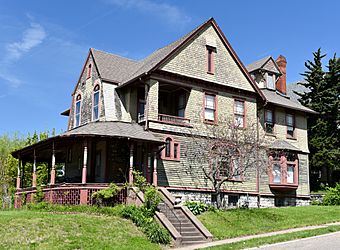Court Hill Historic District facts for kids
Quick facts for kids |
|
|
Court Hill Historic District
|
|
 |
|
| Location | 111 E. Court and 407-1004 N. Court Sts. Ottumwa, Iowa |
|---|---|
| Area | 27 acres (11 ha) |
| Architect | George Kerns Edward Clark |
| Architectural style | Late 19th and 20th Century Revivals |
| MPS | Ottumwa MPS |
| NRHP reference No. | 97001605 |
| Added to NRHP | January 7, 1998 |
The Court Hill Historic District is a special area in Ottumwa, Iowa, United States. It's known for its beautiful old homes. This district is a residential neighborhood with many large houses, and a few smaller ones mixed in.
This historic area was added to the National Register of Historic Places in 1998. This means it's recognized as an important place in American history. When it was added, the district had 84 important features. These included 56 buildings that helped tell its story and two important structures. There were also 25 buildings and one site that didn't add to its historical importance.
Contents
History of Court Hill
Court Street was once a very important road in Ottumwa. It connected the Des Moines River to Sixth Street, which was the edge of the city back then. The road then went up a hill and into the countryside.
Early Days of Court Street
It's thought that this road was first made by the Iowa government in 1844. It stretched from the southern border of Davis County, Iowa to the northern border of Wapello County, Iowa. This road helped connect the main towns, called county seats, in both counties. Later, it became known as U.S. Highway 63.
The very first houses in the Court Hill area were built a long time ago, between 1865 and 1875.
Modern Changes and Growth
In 1889, the first electric streetcar started running on Court Street. This made it easier for people to travel. Then, in 1890 and 1891, the street was paved with bricks. These improvements helped the area grow a lot between 1890 and 1915.
From this time until 1942, the city had a special heating system. Main pipes for this system were under Court Street. This meant the street never had snow or ice in winter. People could always get up the hill, even when other streets were blocked.
During World War II, many of the big houses in the district were divided into smaller apartments for multiple families. Later, in the late 1900s, people started to care more about saving old buildings. This movement, called historic preservation, helped bring the large homes back to their original single-family use.
Architecture Styles
Most of the houses in the Court Hill Historic District are quite large. However, you can also find a few smaller homes scattered around. Even though some houses have been changed over time, most of them still look very much like they did when they were first built.
Building Styles and Designers
Very few of the original buildings in the district have been torn down. This means there aren't many new buildings here. The houses show off many popular Victorian styles. These include Italianate, Neoclassical, and Queen Anne styles.
Some famous architects designed buildings in this district. These include George Kern, Edward Clark, and the team of Fisher & Lowrie.



